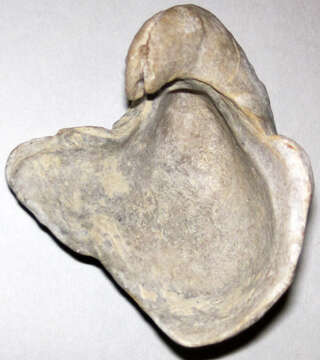Texigryphaea mucronata (fossil oyster) (Walnut Formation, Lower Cretaceous; Bell County, Texas, USA) 3

Description :
Description: English: Texigryphaea mucronata (Gabb, 1869) - fossil oyster shell from the Cretaceous of Texas, USA. (interior view of left valve) Orientation: Top - dorsal Bottom - ventral To the right - anterior To the left - posterior side & posterior flange Most modern and fossil clams have asymmetrically-shaped but equal-sized shells that are mirror images of each other. Oyster shells depart radically from this general rule. The Gryphaea oysters evolved a greatly enlarged, coiled, highly convex left valve & a greatly reduced, concave right valve. The overall shape of gryphaeid oyster shells was a consequence of their living on soft, fine-grained substrates. All oysters are filter feeders, and practically all are hard substrate encrusters at some point in their ontogeny. The highly coiled Gryphaea oysters are free-living forms as large adults. Their shell shape appears to be the result of repeated downward toppling into the mud along the ventral margin of the left valve by the weight of the shell. Classification: Animalia, Mollusca, Bivalvia, Pteriomorphia, Pterioida, Ostreina, Ostreoidea, Gryphaeidae Stratigraphy: Walnut Formation, Fredericksburg Group, Albian Stage, upper Lower Cretaceous Locality: unrecorded/undisclosed site in Bell County, east-central Texas, USA. Date: 27 October 2020, 15:52:50. Source: https://www.flickr.com/photos/47445767@N05/50553747992/. Author: James St. John.
Inclus dans les pages suivantes :
- Biota
- Eukaryota (eucaryotes)
- Unikonta
- Opisthokonta
- Distaplia
- Filozoa
- Apoikozoa
- Animalia
- Eumetazoa
- Bilateria
- Protostomia
- Lophotrochozoa
- Mollusca (mollusques)
- Bivalvia
- Pteriomorphia
- Ostreida
- Gryphaeidae
- Pycnodonteinae
- Texigryphaea
Cette image ne figure dans aucune collection.
Informations sur la provenance
- licence
- cc-by-3.0
- droit d’auteur
- James St. John
- créateur
- James St. John
- source
- James St. John (47445767@N05)
- original
- fichier de média d’origine
- visiter la source
- site partenaire
- Wikimedia Commons
- ID


